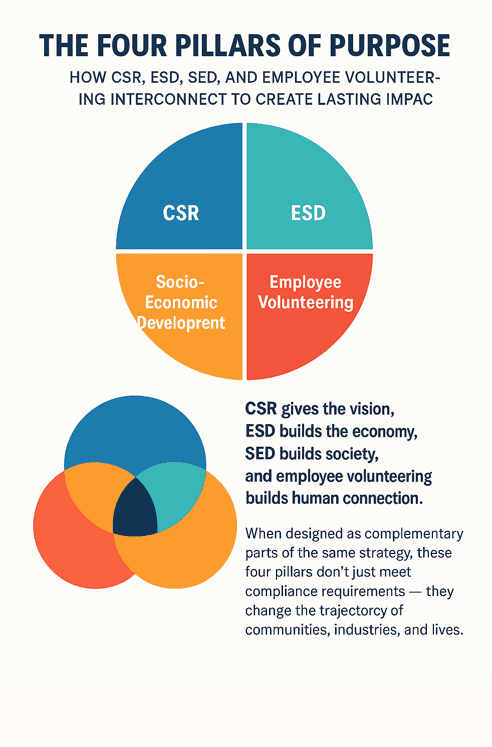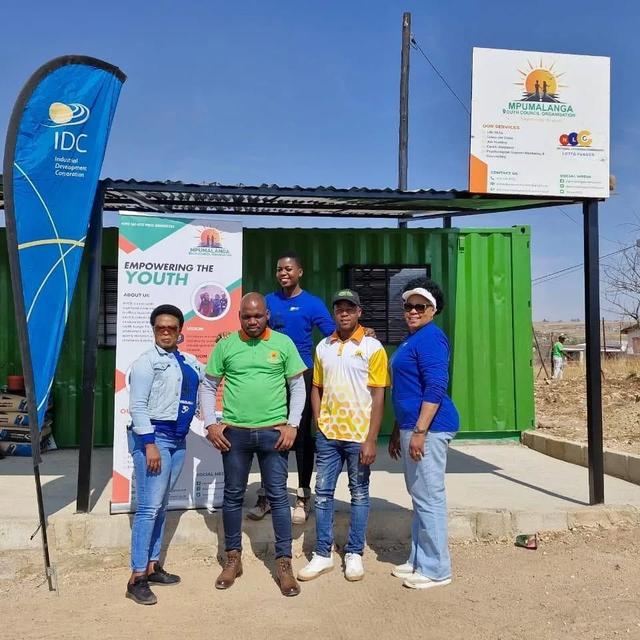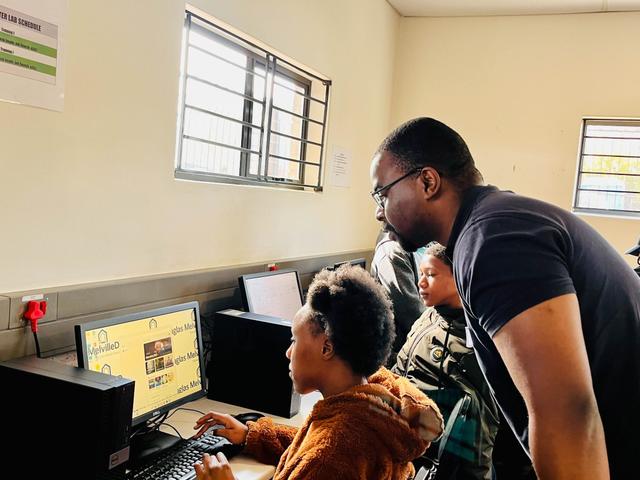
- Home
- Information Centre
- Double Your Impact By Merging Csi Esd Sed And Employee Volunteering
Double your impact by merging CSI, ESD, SED and Employee Volunteering
In today’s business environment, social responsibility is no longer a “nice-to-have”, it’s an expectation from customers, employees, investors and communities.
Yet, many companies still treat their Corporate Social Investment (CSI) initiatives, Enterprise and Supplier Development (ESD) commitments, Socio-Economic Development (SED) projects and employee volunteering programmes as separate streams of work.
The truth is: while these four areas have distinct objectives, they are most powerful when designed to complement each other. When integrated strategically, they create a multiplier effect - delivering deeper community impact, stronger supplier ecosystems, and greater employee engagement.
Retail Sector (Food Security)
ESD: A retailer develops local smallholder farmers as suppliers, ensuring sustainable produce sourcing.
SED: Surplus food from these farms is directed to school feeding schemes.
CSI: The retailer funds cold storage facilities for community co-ops to reduce food waste.
Volunteering: Employees volunteer to run nutrition workshops in schools.
👉Integration outcome: A stronger supply chain, improved child nutrition, job creation, and engaged employees.
1. Corporate Social Investment (CSI)
CSI is the overarching philosophy that frames a company’s social and environmental commitments. It’s about aligning business practices with broader societal needs — from sustainability and ethical sourcing to community investment and governance.
Purpose: To ensure that the company’s operations and values actively contribute to the wellbeing of society, beyond profit-making.
Example: Financial Sector (Ethical Governance & Inclusion):
A bank’s CSI strategy focuses on financial inclusion and ethical governance. This translates into:
ESD: Supporting black-owned fintech startups that create affordable financial tools.
SED: Offering scholarships and digital literacy programmes for rural youth.
Volunteering: Staff volunteer as mentors for small business owners.
→ Result: Trust, transparency, and empowerment across the value chain.
2. Enterprise and Supplier Development (ESD)
In the South African context, ESD is both a legal and moral imperative. It focuses on developing small and medium enterprises — often from historically disadvantaged groups — and integrating them into corporate supply chains.
Purpose: To create economic inclusion, build sustainable supply chains, and stimulate local entrepreneurship.
How it connects: ESD builds the economic backbone of communities by enabling small businesses to grow and integrate into larger supply chains. For example, imagine a large retailer supporting a local farming cooperative through ESD. The cooperative not only becomes a supplier to the retailer but also creates jobs in the community, buys services from other local businesses, and contributes produce to school feeding schemes (SED). In turn, the retailer’s employees may volunteer their time to mentor the cooperative’s youth members, blending CSI with community upliftment. This illustrates how ESD doesn’t operate in isolation — it strengthens and is strengthened by SED and CSI initiatives.
Example: Manufacturing (Textiles & Clothing)
A corporate clothing supplier develops a small, black-owned textile manufacturer through ESD. The business grows to supply uniforms and protective gear, creating jobs for women in the community. Through SED, the factory runs skills workshops for unemployed youth. CSI links in when the corporate donates unused materials for community sewing projects, while staff volunteer to mentor young entrepreneurs in design and business skills.
3. Socio-Economic Development (SED)
SED targets broader social upliftment — improving education, healthcare, housing, and other quality-of-life measures, particularly in under-resourced communities.
Purpose: To address systemic social inequalities and foster long-term community resilience.
Example: Education & Entrepreneurship Pipeline
A corporate invests in upgrading classrooms and digital learning facilities in rural schools as part of its SED focus.
With better education access, more learners complete matric and qualify for entrepreneurship or skills programmes.
These youth later join the company’s ESD incubator, starting small businesses that feed into its supply chain.
CSR ensures sustainability through bursaries and infrastructure maintenance.
Employees volunteer as maths and science tutors, bridging the skills gap.
👉Outcome: A full-circle model — from education (SED) to enterprise (ESD) — that builds lasting community capability.
4. Employee Volunteering
Employee volunteering transforms purpose from a corporate statement into a lived experience. It’s the human side of social impact — where staff donate their time, skills, and expertise to causes they care about.
Purpose: To engage employees in meaningful social contribution, boost morale, and strengthen the link between personal values and the company’s mission.
Example: Skills-Based Volunteering for Youth Empowerment
A financial services company encourages its employees to volunteer as mentors and trainers for youth entrepreneurship programmes.
SED connection: Employees host financial literacy workshops at schools and community centres.
ESD connection: Staff with business expertise provide coaching to small business owners in the company’s ESD incubator.
CSI connection: This aligns with the company’s broader CSI commitment to financial inclusion.
👉Outcome: Youth gain practical skills, small businesses become more resilient, and employees feel proud of their contribution.
Why These Departments Often Don’t Collaborate
Despite the natural synergies, these four functions often work in isolation. Common reasons include:
- Different mandates and KPIs: CSI may focus on brand reputation, ESD on supplier spend, SED on compliance points, and volunteering on employee engagement — making shared goals harder to define.
- Separate budgets: Funding often sits in different cost centres, creating competition rather than cooperation.
- Organisational silos: Departments may report to different executives, limiting communication and joint planning.
- Compliance-driven thinking: When the primary driver is meeting B-BBEE scorecard requirements rather than long-term impact, collaboration can be seen as optional rather than essential.
- Lack of a unifying strategy: Without an overarching vision for social impact, each department optimises for its own outcomes instead of a shared purpose.
Why Collaboration is Critical
When CSI, ESD, SED, and employee volunteering operate in silos, they risk duplicating efforts, missing opportunities, or diluting impact. But when these departments collaborate:
- Resources are optimised — budgets, networks, and skills are pooled for bigger, better results.
- Impact is multiplied — ESD suppliers benefit from SED community upliftment; SED projects gain skills from employee volunteers; CSI provides strategic direction that aligns them all.
- Consistency builds trust — communities, employees, and partners see a coherent, united commitment rather than fragmented projects.
- Agility improves — departments can quickly respond to emerging social or economic challenges because they are already aligned and communicating.
Ultimately, collaboration ensures that each programme doesn’t just achieve its own targets but contributes to a shared, larger vision of sustainable impact.

The Future: Convergence Over Silos
The companies leading in social impact aren’t the ones doing the most projects - they’re the ones integrating them. CSI gives the vision, ESD builds the economy, SED builds society, and employee volunteering builds human connection.
When designed as complementary parts of the same strategy, these four pillars don’t just meet compliance requirements — they change the trajectory of communities, industries, and lives



![[WEBINAR] Leveraging skills-based employee volunteering to amplify CSI](/_next/image?url=https%3A%2F%2Fcdn.sanity.io%2Fimages%2Fxquleem7%2Fproduction%2Fd64d551fd490d43a6dd186f3df8edd38aa084a18-1270x710.png&w=640&q=75)

